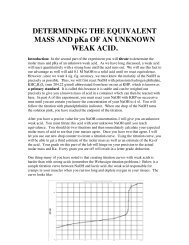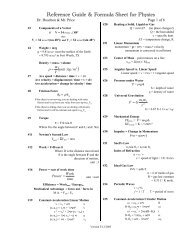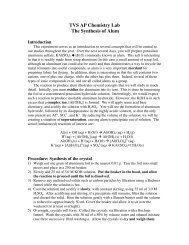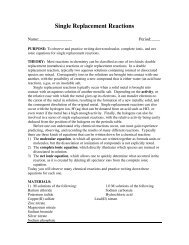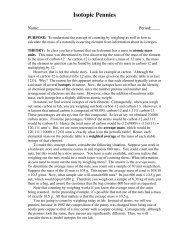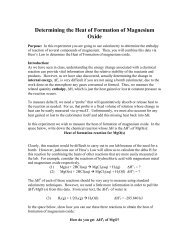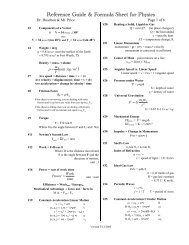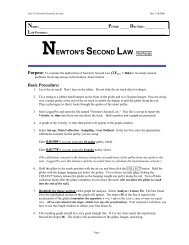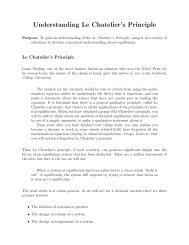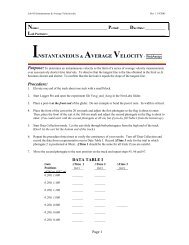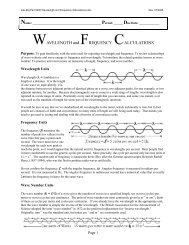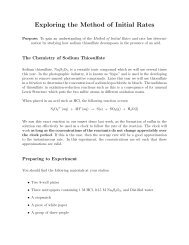Reference Guide & Formula Sheet for Physics - 2006 Version
Reference Guide & Formula Sheet for Physics - 2006 Version
Reference Guide & Formula Sheet for Physics - 2006 Version
You also want an ePaper? Increase the reach of your titles
YUMPU automatically turns print PDFs into web optimized ePapers that Google loves.
<strong>Reference</strong> <strong>Guide</strong> & <strong>Formula</strong> <strong>Sheet</strong> <strong>for</strong> <strong>Physics</strong><br />
Dr. Mitchell A. Hoselton <strong>Physics</strong> − Douglas C. Giancoli Page 3 of 16<br />
Chapter 02. – continued<br />
Constant Acceleration is rare in nature but common in<br />
the problems we will be working. Constant acceleration<br />
gives the equations of motion their simplest <strong>for</strong>m and<br />
makes them easier to solve. Gravity provides a ready<br />
source of objects moving with constant acceleration.<br />
Strictly speaking, we cannot define average acceleration<br />
until we have a definition <strong>for</strong> instantaneous velocity.<br />
Then the average acceleration is<br />
a AVG = average acceleration<br />
= velocity change/∆time = ∆v/∆t<br />
When the acceleration is constant, the instantaneous and<br />
average acceleration have the same magnitude and<br />
direction. Since the instantaneous acceleration is the<br />
same at all moments, the average acceleration must have<br />
the same magnitude and direction.<br />
One dimensional vectors<br />
To this point, we’ve used only vectors that behave<br />
exactly like signed numerical values, where the sign<br />
indicates the direction along the axis of motion.<br />
Vectors can also be thought of as arrows with pointed<br />
ends showing the direction of the motion. We could<br />
even use these arrows to describe the one-dimensional<br />
vectors discussed in this chapter.<br />
In the next chapter, where objects are free to move in<br />
two dimensions, we will use the arrow representation<br />
first. There is also a method that allows us to reuse the<br />
vector concepts from this chapter; the signed numbers.<br />
We will separate the vectors into what are call their<br />
components. Components are independent onedimensional<br />
sub-sets of the motion.<br />
Chapter 03. –<br />
Components of a Vector and Vector Addition<br />
V = v ∠θ = 34.0 m/s ∠48.0°<br />
v x = v cos θ = 34 m/s•(cos 48°) = 22.8 m/s<br />
v y = v sin θ = 34 m/s•(sin 48°) = 25.3 m/s<br />
V = v x i + v y j = 22.8 i + 25.3 j m/s<br />
W = w ∠θ = 52.0 m/s ∠113.0°<br />
w x = w cos θ = 52 m/s•(cos 113°) = −20.3 m/s<br />
w y = w sin θ = 52 m/s•(sin 113°) = 47.9 m/s<br />
w = w x i + w y j = −20.3 i + 47.9 j m/s<br />
Chapter 03. – continued<br />
V + w = (22.8−20.3) i + (25.3+47.9) j m/s<br />
V + w = 2.5 i + 73.2 j m/s = w + V<br />
V − w = (22.8−(−20.3)) i + (25.3−47.9) j m/s<br />
= 43.1 i − 22.6 j m/s<br />
w − V = (−20.3−22.8) i + (47.9−25.3) j m/s<br />
= −43.1 i + 22.6 j m/s<br />
V − w and w − V, point in opposite directions and<br />
both are perpendicular to V + w = w + V.<br />
Projectile Motion – working with components<br />
Horizontal position: x−x ο = v x •t<br />
Vertical position: y−y ο = v y0 •t − ½•g•t²<br />
Horizontal velocity: v x = v 0 cos θ<br />
Vertical velocity: v y = v 0 sin θ – gt 2<br />
Horizontal acceleration: a x = 0<br />
Vertical acceleration: a y = −g = constant<br />
Chapter 04. –<br />
Newton’s First Law – Law of Inertia. Forces make<br />
objects move. No <strong>for</strong>ce means no change in the motion.<br />
Newton's Second Law – Forces cause acceleration.<br />
F net<br />
= ΣF Ext = m sys •a sys<br />
Newton’s Third Law – Forces are created in pairs.<br />
Weight = W = m•g<br />
g = 9.80m/s² near the surface of the Earth<br />
= 9.795 m/s² in Fort Worth, TX<br />
Friction Force = F F = µ•F N<br />
If the object is not moving, you are dealing with static<br />
friction and it can have any value from zero up to µ S<br />
F N<br />
If the object is sliding, then you are dealing with kinetic<br />
friction and it will be constant and equal to µ K<br />
F N<br />
Free-Body Diagram – Show all the <strong>for</strong>ces acting on and<br />
object. Components must be dashed to distinguish them<br />
from <strong>for</strong>ces. You cannot use a <strong>for</strong>ce and its components<br />
in the same problem.<br />
<strong>Version</strong> 6/5/<strong>2006</strong>





